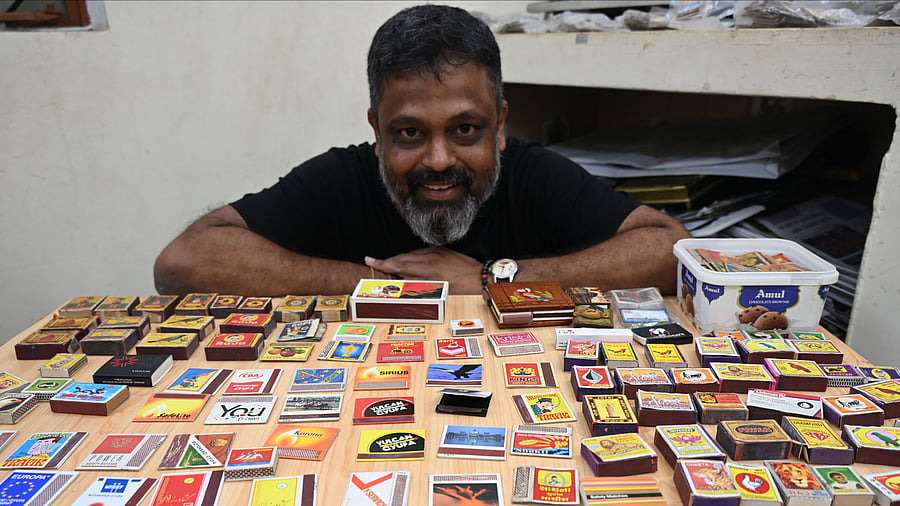
Kiran Munipalle has in his collection matchboxes, labels, and cases.
Credit: DH Photo/B K Janardhan
As children, Kiran Munipalle and his friends would play lagori with matchboxes instead of flat stones. This inventive version of the street game sparked in Munipalle a passion for collecting matchboxes in high school. Today, at 44, he owns at least 10,000 match-related curios spanning 30 countries and beyond.
When Metrolife visited his home near Uttarahalli recently, he had displayed “50% of his collection” on a sofa, a table, a cabinet stand and a part of the floor in the living room. The rest was bundled away in a duffle bag and in plastic covers in one corner of the room.
The oldest match label in the assortment was a lithograph print of a lion, “dating back to early 1940s and manufactured in Gujarat’s Cambay, one of the earliest matchbox manufacturing centres in India”. Labels are stickers bearing the brand logo or name, artwork, or manufacturing location that go on top of the matchbox.
Matchboxes were a popular medium of advertisement back in the day and labels in his possession illustrate how brands promoted hotels, bikes, banks, firecrackers and agarbattis.
“Error matches” are sought after, he added, referring to a label that had wrongly printed the photo of actress Khushbu on both sides. The Karnataka-centric labels had actor Rajkumar, Vidhana Soudha, and a beer promotion by Mysore Breweries Limited on them.
The investment banker, who is into watchmaking now, also showed us limited-edition labels from Austria featuring images of topless women. He also flipped some matchboxes to show recipes and music trivia printed on the back.
“My focus is Swedish match labels featuring Indian artwork, such as royalty. Their attention to detail in the artwork, typography and composition was superior to Indian-made labels,” Munipalle said, pointing to a fisherman killing a crocodile on a label.
The school hobby became a serious pursuit around 2014-15 when he discovered a circle of hobbyists in India and abroad. He then also learnt of the term phillumenist, a person who collects matchboxes and match labels. Then, he began bartering his collection with others to “score” what he wanted. “I swapped around 500 Indian matchboxes for 50 Swedish matchboxes from a collector in Holland. The late Gautam Hemmady, the biggest matchbox collector in India, gave me five match labels printed with Raja Ravi Varma paintings in exchange for 300 Indian labels with themes like flora and fauna,” he said.
On the side, he was “rescuing” matchboxes from gutters, dustbins, and under buses. Once, he returned from a holiday to northeast India and Nepal with over 1,000 empty matchboxes. “Since flammable items are barred on the flight, we gave the matchsticks to a domestic worker at our relative’s home in Siliguri,” his wife Sowmya explained. Another 1,000 match labels came his way from a stranger in Banashankari. “In his teaching days, he would use the labels to show birds, animals, landmarks, vehicles, and gods to children in government schools,” said Munipalle about the retired school principal, who was bedridden when he
met him.
To request a visit, call 98803 83200/97418 67777.